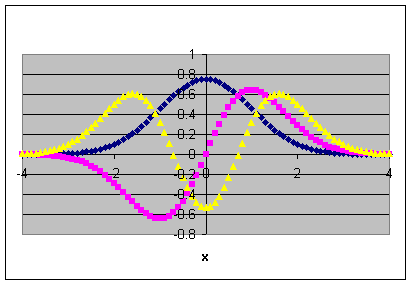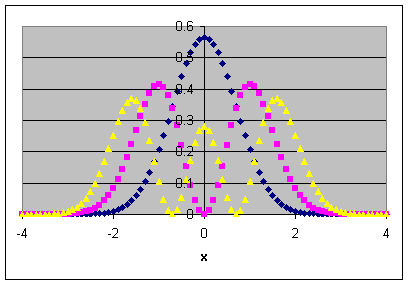Harmonic potentials, eigenvalues and eigenfunctions
Problem:
Find the average kinetic energy and the average potential energy of a
particle in the ground state of a simple harmonic oscillator with frequency ω0.
Solution:
- Concepts:
Virial theorem
- Reasoning:
<T> = <U> for the harmonic oscillator.
- Details of the calculation:
<E> = <T> + <U> = ½ħω0
for the ground state.
Therefore <T> = <U> = ¼ħω0.
Problem:
Consider
the one-dimensional problem in which a particle of mass m and charge -q is placed
in a harmonic oscillator potential U(x) = ½mω2x2 in the presence of an electric field E = E0.
(a) Write down the Hamiltonian H.
(b) Find the eigenvalues of H.
(c) Find <x> for all eigenstates
of H.
Solution:
- Concepts:
The eigenfunctions of the harmonic oscillator
- Reasoning:
By changing the variable x to x' = x + qE0/(mω2)
we can make H look like the Hamiltonian of a simple harmonic oscillator.
- Details of the calculation:
(a) H = ½P2/m
+ ½mω2X2 + qE0X.
(b) H|Φ> = E|Φ> ∂2Φ(x)/∂x2 + (2m(E -
½mω2x2 - qE0x)/ħ2)Φ(x) = 0.
Let us try to complete the square.
∂2Φ(x)/∂x2 + (2m(E -
½mω2(x + qE0/(mω2))2 - q2E02/(2mω2))/ħ2)Φ(x) = 0.
Let x' = x + qE0/(mω2),
E' = E - q2E02/(2mω2). Then
∂2Φ(x')/∂x'2 + (2m(E' - ½mω2x'2)/ħ2)Φ(x') = 0.
This is the equation for a harmonic oscillator in the absence of an
electric field.
En' = (n + ½)ħω, En = (n + ½)ħω - q2E02/(2mω2).
(c) <x'> = 0 for all eigenstates, <x> = -qE0/(mω2)
for all eigenstates.
Problem:
(a) Give and
sketch the probability distribution for the second lowest energy solution of the
simple quantum mechanical harmonic oscillator,
-(ħ2/2m)(d2/dx2)Φ(x)
+ ½kx2Φ(x) = EΦ(x),
including the classical oscillator limits for the amplitude of oscillation.
(b) Assume
ψ(x,t = 0) = C0Φ0(x)
+ C1Φ1(x), and
show that at later time
ψ(x,t) = C0Φ0(x)exp(-iE0t/ħ)
+ C1Φ1(x)exp(-iE1t/ħ).
(c) Compute and sketch |ψ(x,t)|2
for different times.
Solution:
- Concepts:
The eigenstates of the harmonic oscillator, evolution operator
- Reasoning:
We are asked to sketch an eigenfunction of the harmonic oscillator and to
find ψ(x,t) given ψ(x,0)
- Details of the calculation:
(a) The three lowest eigenfunctions of the harmonic oscillator are (with k
= mω2)
Φ0(x)
= (mω/(πħ))¼exp(-½mωx2/ħ),
Φ1(x) = ((4/π)(mω/ħ)3)¼ x exp(-½mωx2/ħ),
Φ2(x) = (mω/(4πħ))¼ [2mωx2/ħ
- 1] exp(-½mωx2/ħ).
The probability densities are given by |Φi(x)|2.
Below is a sketch of these functions with mω/h = 1.

The functions
Φ1(x),
Φ2(x)
and
Φ3(x)

The functions |Φ1(x)|2,
|Φ2(x)|2
and
|Φ3(x)|2
En = (n+½)ħω.
For
Φn(x)
the classical oscillator limits for the amplitude of oscillation is found
from
½kA2 = (n + ½)ħω,
½mω2A2 =
(n+½)ħω,
A2 = (2n + 1)ħ/(mω),
A = ((2n + 1)ħ/(mω))½.
(At
the classical oscillator
limits for the amplitude of oscillation the kinetic energy is zero and the
potential energy equals the total energy.)
(b) |ψ(t)>
= U(t,t0)|ψ(t0)>,
U(t,t0) = exp(-(i/ħ)H(t-t0)).
ψ(x,t) =
exp(-(i/ħ)H(t))[C0Φ0(x)
+ C1Φ1(x)]
=
C0Φ0(x)exp(-iE0t/ħ)
+ C1Φ1(x)exp(-iE1t/ħ).
ψ(x,t) =
exp(-mωx2/(2ħ))exp(-iωt)[C'0
exp(iωt/2)
+ C1'x exp(-iωt/2)].
|ψ(x,t)|2
= exp(-mωx2/ħ)
[|C'0|2 + |C1'|2x2 +
2Re(C'0C1'x)cos(ωt)].
Choose mω/ħ
= 1, C'1 = C'2 = 1.
Then |ψ(x,t)|2
= exp(-x2) [1 + x2 + 2xcos(ωt)].

ωt = 0

ωt = π/2

ωt = π
<x>(t) oscillates with frequency ω like the classical coordinate x.
Problem:
A non-relativistic quantum mechanical particle of mass m is
in a 1-dimensional potential,
U(x) = ax2 for x > 0 and U(x) = ∞ for x < 0.
(a) Find the possible energy eigenvalues and normalized eigenfunctions.
(b) The particle is in the ground state. At what position x is it most likely
to be found?
(c) What is the expectation value of the particle position?
Solution:
- Concepts:
The harmonic oscillator
- Reasoning:
For x > 0, the given potential is identical to the harmonic oscillator
potential.
Odd harmonic oscillator energy eigenfunctions are zero at x = 0 and, satisfy
all boundary conditions for x > 0. They are eigenfuctions of H for the
given potential for x > 0. For x < 0, the eigenfunctions of the given H are
zero.
- Details of the
calculation:
(a) The harmonic oscillator eigenfunctions with V(x) = ½mω2x2
are
Φn(x) = (n! 2n)-½ (β/√π)½Hn(η)
exp(-½η2), where η = (mω/ħ)½ x = βx.If we replace ω by (2a/m)½
and multiply the functions with n = odd by
√2, we obtain the normalized eigenfunctions for the given H. The eigenvalues are
En = (n + ½ )ħω = (n + ½ )ħ(2a/m)½,
n = odd.
(b) The ground state wave function is Φ1(x)
= N1 x exp(-(2ma)½x2/(2ħ)),
x > 0,
with N1 = (2/π¼)((2ma)½/ħ)¾
The most probable position is found from d|Φ1(x)|2/dx
= 0.
x - (2ma)½x3/ħ = 0, x = ħ½/
(2ma)¼.
(c) The the expectation value of x is
<x>
= ∫0∞ x |Φ1( x
)|2d x = N12(ħ2/(2ma))∫0∞
y3 exp(-y 2) dy
=
(4/√π)[(2ma)¾/ħ3/2](½ħ2/(2ma)) =
1.13√ħ/(2ma)¼.
<x> = 1.13 ħ½/(2ma)¼.
Problem:
Write down the energy eigenvalues for the one-dimensional Schroedinger
equation with
U(x) = ½ m ω2x2 for x > 0 and U(x) = ∞ for x < 0.
Solution:
- Concepts:
The eigenfunctions of the 1D harmonic oscillator
- Reasoning:
The odd eigenfunctions of the harmonic oscillator with U(x) = ½ m ω2x2
for all x are eigenfunctions of H for this potential.
- Details of the calculation:
The eigenvalues therefore are E = (n + ½)ħω, n = odd
or rewriting, E = (2n + 3/2)ħω, n = 0, 1, 2, ...




